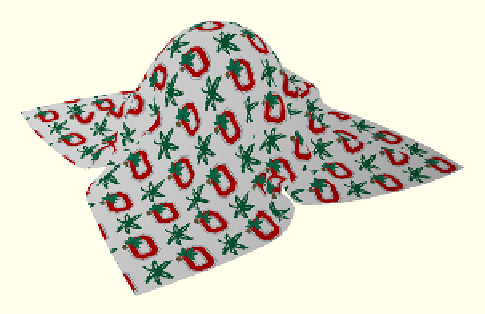Graphics Reference
In-Depth Information
the average of the squares of the distance to each of the neighbors. Self-intersection of the cloth is
ignored. To model material stiffness, the user can add dihedral angle springs to bias the shape of
the material.
Animation of the cloth is produced by animating the existence and/or position of constrained points.
In this case, the relaxation process can be made more efficient by updating the position of points based on
positions in the last time step. Modeling cloth this way, however, is not appropriate for many situations,
such as clothing, in which there are a large number of closely packed contact points. In these situations,
the formation of catenary curves is not an important aspect, and there is no provision for the wrinkling of
material around contact points. Therefore, a more physically based approach is often needed.
7.5.2
Physically based modeling
In many cases, a more useful approach for modeling and animating cloth is to develop a physically
based model of it. For example, see
Figure 7.35
. This allows the cloth to interact and respond to
the environment in fairly realistic ways. The cloth weave is naturally modeled as a quadrilateral mesh
that mimics the warp and weft of the threads. The characteristics of cloth are its ability to stretch, bend,
and skew. These tendencies can be modeled as springs that impart forces or as energy functions that
contribute to the overall energy of a given configuration. Forces are used to induce accelerations on
system masses. The energy functions can be minimized to find optimal configurations or differentiated
to find local force gradients. Whether forces or energies are used, the functional forms are similar and
are usually based on the amount some metric deviates from a rest value.
Stretching is usually modeled by simply measuring the amount that the length of an edge deviates
from its rest length.
Equation 7.88
shows a commonly used form for the force equation of the corre-
sponding spring.
v
1* and
v
2* are the rest positions of the vertices defining the edge;
v
1 and
v
2 are the
current positions of the edge vertices. Notice that the force is a vector equation, whereas the energy
equation is a scalar. The analogous energy function is given in
Equation 7.89
. The metric has been
normalized by the rest length (|
v
1*
v
2*|).
FIGURE 7.35
Cloth example.
(Image courtesy of Di Cao).




Search WWH ::

Custom Search